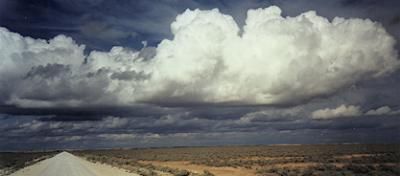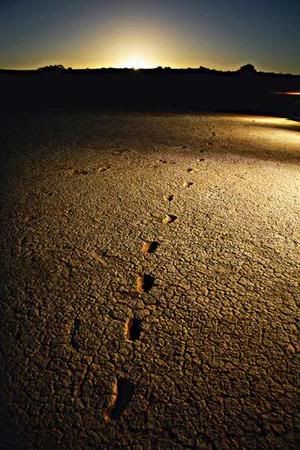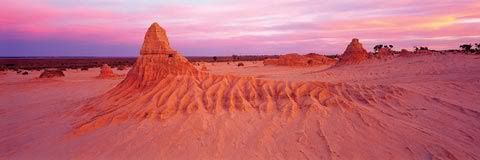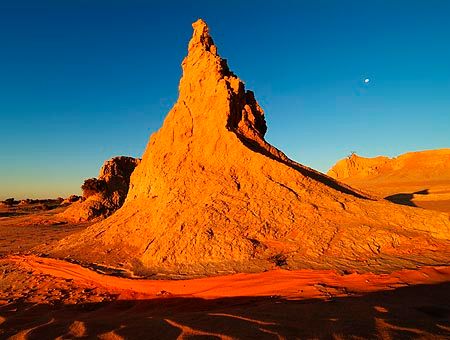Nick's Special Places - Lake Mungo


Shifting sand dunes have revealed hundreds of human foot prints left by children and adolescents at the height of the last ice age at Lake Mungo National Park in the Willandra Lakes region. Dating back to around 20'000 BC these footprints left in the moist clay of the lakes shore have been perfectly preserved for thousands of years since the lake dried up around 14'000 years ago.

An analysis of the footprints in the Journal of Human Evolution has shown that most of the footprints are quite deeply impressed into the sediments, revealing toe marks, arches, heels and balls of the people's feet.
In one place a 135-centimetre tall adolescent walks at right angles to the main tracks, moving up a slope. Elsewhere, a perhaps weary child, with the second smallest footprints found, slows the group's rate of walking from five to three kilometres per hour. There are also kangaroo paw prints. "Some of the men are running and we think they're chasing something," says Webb.
One man, estimated to be 194 centimetres tall, accelerates up to 20 kilometres an hour, his pace length increasing from 1.8 metres to 1.9 metres in less than 12 metres. "The surface on which this person was running was drying mud that left detailed impressions of foot architecture, with mud oozing between the toes, and the slight heal slippage on the surface,".
The information that these fossilized footprints will reveal is astounding to say the least and the discovery has given me a great excuse to get my shit together to plan another visit to this truly amazing place.

The Dunes at Lake Mungo
The reason why my ancient history class took a trip to Mungo is because it's also home to the to the oldest known cremation in the world - Mungo Lady's remains- and the oldest known ritual burial in the world - Mungo Man's ochre-covered skeleton which were discovered in the late 60's and early 70's and have both been carbon dated to around 40'000 years old
The trip taken in Year 11 at School was my first journey deep into the Australian desert and while I can't put my finger on the emotionally overwhelming feeling I got from visiting this place it is something that I have never forgotten and have wanted to experience again ever since I left.

I guess its because It's too remote for tourists and the place is just so untouched and unaffected by times progress. Even though the lake dried up thousands of years ago the evidence of ancient life there is endless with piles of mussell shells and tools beside carbon charcoal remains of campfires lit in the tens of thousands of years ago found easily along the lunette - the remains of the lakes shore.

Lake Mungo is Australia's own East Africa, our Rift Valley and with more inevitable discoveries to be made revealing life of early man here I highly recommend checking this place out if you ever get the chance. Just don't tell the Tourists!!, and there's no crappy gift shop here anyway!!

2 Comments:
Great pics Nicky but I can't believe you buy into all that evolution clap trap. Didn't you know that the world is only 5,000 years old and that man was walking the planet at the same time as the dinasaurs?
We all know that here in America cause our president told us all about it so it must be true.
(We also never ever torture)
There are some truly AMAZING things in Australia, but unfortunately they are a bugger to get to.
In 1946 a surveying geologist, R. C. Sprigg, was in the Flinders Ranges in South Australia. While eating his lunch he turned over a rock to find a cool spot to put his drink bottle - and found one of the oldest traces of life.
What he found has come to be called the Ediacara biota and at 580 to 543 million years old (Ma) it represents the most ancient complex organisms on Earth.
Unless of course Scott is right and it’s all just a conspiracy cooked up by those satanic old scientists to deflect us from gods’ greater plan.
Post a Comment
<< Home